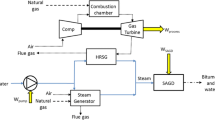Abstract
Global Warming caused by the Greenhouse gas has become a serious global issue due to the increasing in the use of fossil fuel and it is being exhausted. Recently, a great deal of research is being carried out to develop alternatives to fossil fuels. The oil sands have become one of the alternative energy sources. However, it is composed of about 10% bitumen and the rest becomes waste. Moreover, oil sands need a large amount of natural gas to provide heat and steam for bitumen extraction. In this study, it has been focused on the satisfaction both CO2 reduction and waste disposal by using spent oil sand after extraction bitumen from oil sand. Additionally, Aspen Plus was used to simulate to know about its carbonation reactivity. First, we analyzed the analysis of spent oil sand and discovered that it is of mostly composed of SiO2, so it needs pretreatment with CaO aqueous solution. After the pretreatment, it is performed by changes in temperature and pressure. The optimum is decided 500°C, 25 atm and reduced rate of mass was calculated 21.92% about carbonation reactivity by using simulation.
Access this chapter
Tax calculation will be finalised at checkout
Purchases are for personal use only
Similar content being viewed by others
References
Woynillowicz D, Baker CS, Raynolds M. Oil sands fever. Drayton Valley: Pembina Institute’s Publication; 2005. p. 16, 22.
Romanov AN. Effect of high-hygroscopicity salts on the dielectric properties of saline soils in the decimeter wave band. J Commun Technol Electron. 2008;53(3):304–6.
Roo WH, Kwon TR, Lee WM, Lee CW, Ahn JY, Baek IH. Characteristics of carbonation and decarbonation of carbon dioxide over calcium oxide. Hwahak Konghak. 2003;41(5):662.
Titelman GI, Gelman V, Bron S, Khalfin RL, Cohen Y, Bianco-Peled H. Characteristics and microstructure of aqueous colloidal dispersions of graphite oxide. J Am Carbon Soc. 2005;43(3):647.
Garbev K, Bornefeld M, Beuchle G, Stemmermann P. Cell dimensions and composition of nanocrystalline calcium silicate hydrate solid solutions. Part 2: x-ray and thermogravimetry study. J Am Ceram Soc. 2008;91:3015–23.
Acknowledgment
This study was promoted by Korea Energy Management Corporation and the Korea government Ministry of Knowledge Economy as part of the project ‘Development of carbon dioxide Sequestration by using spent oil sand’.
Author information
Authors and Affiliations
Corresponding author
Editor information
Editors and Affiliations
Rights and permissions
Copyright information
© 2013 Springer-Verlag Berlin Heidelberg & Tsinghua University Press
About this paper
Cite this paper
Han, D., Jang, D., Jeon, Y., Kim, H. (2013). Comparison of CO2 Fixation in Spent Oil Sand Between Experiment and Simulation. In: Qi, H., Zhao, B. (eds) Cleaner Combustion and Sustainable World. ISCC 2011. Springer, Berlin, Heidelberg. https://doi.org/10.1007/978-3-642-30445-3_182
Download citation
DOI: https://doi.org/10.1007/978-3-642-30445-3_182
Published:
Publisher Name: Springer, Berlin, Heidelberg
Print ISBN: 978-3-642-30444-6
Online ISBN: 978-3-642-30445-3
eBook Packages: EnergyEnergy (R0)




